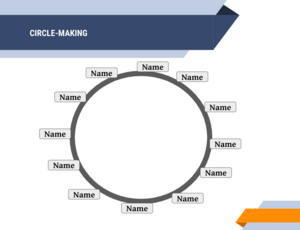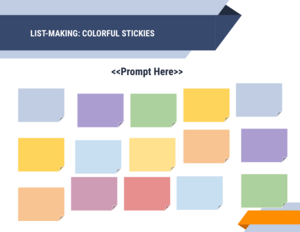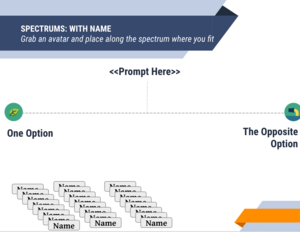Facilitation 101: Difference between revisions
No edit summary |
|||
| Line 152: | Line 152: | ||
{| class="wikitable" style="border-collapse: collapse; width: 83.2539%; height: 158px; background-color: rgb(255, 255, 255);" | {| class="wikitable" style="border-collapse: collapse; width: 83.2539%; height: 158px; background-color: rgb(255, 255, 255);" | ||
|- style="height: 20px;" | |- style="height: 20px;" | ||
| style="width: 11.5738%; background-color: #99e1d9; height: 20px;" | <span style="color: rgb(0, 0, 0);" >'''<span>Prioritization dots</span>'''</span> | | style="width: 11.5738%; background-color: #99e1d9; height: 20px;" | <span style="color: rgb(0, 0, 0);">'''<span>Prioritization dots</span>'''</span> | ||
| style="height: 20px; width: 64.0131%;" | | | style="height: 20px; width: 64.0131%;" | | ||
*Helps to whittle down a long list of options into something more manageable. | *Helps to whittle down a long list of options into something more manageable. | ||
*Everyone in the group is allowed the same number of 'dots', e.g. five (this could simply be dots they draw on with their own pens or drag on a screen). They can 'spend' these dots between their five priority options, or choose a different weighting (e.g. three dots on an idea they are very keen on, and then one each on their next two favoured options). | *Everyone in the group is allowed the same number of 'dots', e.g. five (this could simply be dots they draw on with their own pens or drag on a screen). They can 'spend' these dots between their five priority options, or choose a different weighting (e.g. three dots on an idea they are very keen on, and then one each on their next two favoured options). | ||
|- style="height: 23px;" | |- style="height: 23px;" | ||
| style="width: 11.5738%; background-color: #99e1d9; height: 23px;" | <span style="color: rgb(0, 0, 0);" >'''Pros and cons or plus/minus/interesting'''</span> | | style="width: 11.5738%; background-color: #99e1d9; height: 23px;" | <span style="color: rgb(0, 0, 0);">'''Pros and cons or plus/minus/interesting'''</span> | ||
| style="width: 64.0131%; height: 23px;" | *Listing the benefits and drawbacks of different ideas can be a good way to explore different viewpoints without people taking it too personally. | | style="width: 64.0131%; height: 23px;" | | ||
*Listing the benefits and drawbacks of different ideas can be a good way to explore different viewpoints without people taking it too personally. | |||
*This can also be a starting point for a deeper exploration of what people really want to achieve and avoid. Some people will find it hard to engage with an abstract question like "What are your core needs?" Listing the reasons why they like or don't like particular ideas may help them notice and explain what they want and don't want. | *This can also be a starting point for a deeper exploration of what people really want to achieve and avoid. Some people will find it hard to engage with an abstract question like "What are your core needs?" Listing the reasons why they like or don't like particular ideas may help them notice and explain what they want and don't want. | ||
|- | |- | ||
| style="width: 11.5738%; background-color: | | style="width: 11.5738%; background-color: rgb(153, 225, 217);" | <span style="color: rgb(0, 0, 0);">'''Maximize/minimize'''</span> | ||
<span style="color: rgb(0, 0, 0);" >''' | | style="width: 64.0131%;" | | ||
| style="width: 64.0131% | *Maximise/Minimise questions aim to draw on specific insight. | ||
*For example, a maximising question might sound like, “How, in your experience, do you maximise the value of a social media post? For example, when you see a post about an upcoming protest, what maximises the chance of you attending their event?” | |||
* | *A minimizing question might sound like, "What would minimize your chance (or our target audience's chance) of attending our event?" | ||
|- style="height: 23px;" | |- style="height: 23px;" | ||
| style="width: 11.5738%; background-color: #99e1d9; height: 23px;" | <span style="color: rgb(0, 0, 0);" >'''Spectrum tool'''</span> | | style="width: 11.5738%; background-color: #99e1d9; height: 23px;" | <span style="color: rgb(0, 0, 0);">'''Spectrum tool'''</span> | ||
| style="width: 64.0131%; height: 23px;" | | | style="width: 64.0131%; height: 23px;" | | ||
*Use the spectrum tool to help gauge where people are at. If you're virtual, you can also do this anonymously with figures instead of names. | *Use the spectrum tool to help gauge where people are at. If you're virtual, you can also do this anonymously with figures instead of names. | ||
[[File:Screen Shot 2023-07-07 at 11.04.11 AM.png|300x300px|center|border]] | [[File:Screen Shot 2023-07-07 at 11.04.11 AM.png|300x300px|center|border]] | ||
Revision as of 15:55, 9 August 2023
This page was created to provide tips and suggestions for activists related to facilitating meetings and events. This guide reflects several questions the HUB community has raised on facilitation.
The information included comes from existing organizer databases and resources and advice from movement thinkers. A special thanks to HUB advisor Amara Possain, who thoughtfully shared their expertise with the HUB team. Their knowledge is shared throughout. We encourage readers to share further ideas on how this page can be expanded upon and improved.
This guide includes... definers of good vs bad facilitation, tools for good facilitation, including activities and suggestions for increasing participant engagement, and suggestions for managing group dynamics.
What do we mean by facilitation? [1] [2]
The role of a facilitator is to drive meeting or event participants towards clarity. Facilitation move things forward and build momentum. Facilitators also bring participants back to the purpose of the event/meeting. Remembering your purpose is key, so that when someone is taking up too much space, the facilitator can remind that you'd like to bring us back to the purpose and our goals. -Amara Possain, HUB advisor
In other words, the role of a facilitator and the purpose of facilitation is to: Source: adapted from Meeting Facilitation: The No-Magic Method (Berit Lakey) and Seeds for Change.
|
Take responsibility for helping the group stay on track and move through the agenda within the available time. |
|
Suggest how to move the group forward, rather than making decisions or plans for the group. |
|
Regulate the flow of discussion. |
|
Track decisions and milestones, providing clarity on the group's journey, clarifying and summarizing points. |
|
Prioritize the collective needs and goals of the group over individual within the group. |
Note: A person who has strong opinions or significant investment in the decisions being made may find it challenging to facilitate effectively. In some situations, it can be helpful to have an external facilitator.
What makes for poor facilitation?
The following reflections were raised by CAN-RAC and HUB team members in a joint workshop developed and delivered by Amara Possain:
- No agenda, no steering, lack of organization
- Repetition
- Lack of momentum
- Not stepping in to help pull out the positives (groups tend to focus on negatives)
- Not stepping in when some people are taking up too much space
- Not knowing the audience and how to tailor facilitation
- Not stepping in to get people back on track, when people hijack space
- Low engagement and energy, lack of initiative
- Not being able to move past certain items
- People weaponizing meeting rules and knowledge of process
- Passive aggressiveness
- Unclear roles in non-hierarchical structure
- Interrupting each other
- “Outfacilitating" the facilitator - often around an unbalanced power dynamic
- Miscommunications / inability to diagnose where we departed in understanding
Key facilitation skills [3]
- Active listening enables us to hear what others are saying;
- Questioning helps clarify what people are saying, or supports people to explore their needs and come up with new possibilities;
- Summarising helps remind us of the key points in the discussion and check we have the same understanding;
- Synthesising is the skill that allows us to draw together different views and ideas to form one proposal that works for everyone.
Good facilitation should result in good meetings with [4] :
- Clearly defined and mutually understood goals.
- A well-defined process for effectively achieving those goals.
- Recognition that participants bring their personal preoccupations and emotions alongside their interest in the subject matter.
- Fostering a sense of involvement and empowerment, allowing participants to feel ownership over the decisions and able to take necessary actions.
Tools for good facilitation
The following sections include a compilation of suggestions from Seeds for Change' [5] ', Amara Possain (HUB advisor, Daniel Hunter (350.org training director) [6] and the Anarchist Library [7] . Suggestions are relevant to virtual, in-person and hybrid meetings and events.
For opening and beginning the meeting/event
| Stop and P-O-P [8] |
|
| Build trust and ground attendees |
|
|
Make sure people know how the meeting/event works |
|
| Engage people early and often - set the tone in the first few minutes |
|
| Try the circle up tool! |
 |
| Explain the proposed agenda, and ask for amendments | *Be conscious of how long this process is taking– it’s better to be firm and go ahead with a plan rather than spending half the time talking about what to talk about! |
For discussion and idea raising
For feedback
For ending meeting/events
- Make sure you finish on time, or get everyone’s agreement to continue.
- Ensure someone will be circulating the minutes, notes or slides in the next few days.
- Make sure there’s a time and place set for the next meeting, or share upcoming events!
- Offer a way to evaluate and provide feedback the meeting/event.
- It can be nice to follow the meeting with an informal social activity!
Energizers to increase engagement throughout
Energizers provide a break/rest and can help increase engagement when included between the beginning to the end of a meeting/event [9]
|
Sam Went to Venus |
|
|
Something True About Yourself (from Gerald Gomani, Zimbabwe) |
|
|
Strategy Stretch (from Erika Thorne, USA) |
|
|
Why… Because… (from Gerald Gomani, Zimbabwe) |
|
Suggestions for managing group dynamics
From Amara Possain, HUB advisor and Meeting Facilitation: The No-Magic Method (Berit Lakey)
| Setting the tone |
|
| Specific practices |
|
|
Handling specific situations |
|
If you have any suggested revisions or additional resources to share related to the above content, please email them to kenzie@lehub.ca.

- ↑ https://www.trainingforchange.org/training_tools/meeting-facilitation-the-no-magic-method/
- ↑ https://www.seedsforchange.org.uk/facilitationmeeting
- ↑ https://www.seedsforchange.org.uk/facilitationmeeting
- ↑ https://www.trainingforchange.org/training_tools/meeting-facilitation-the-no-magic-method/
- ↑ https://www.seedsforchange.org.uk/facilitationmeeting
- ↑ https://trainings.350.org/resource/online-monster-manual/
- ↑ https://theanarchistlibrary.org/library/c-t-butler-and-amy-rothstein-on-conflict-and-consensus-a-handbook-on-formal-consensus-decisionm#toc76
- ↑ http://stproject.org/
- ↑ https://trainings.350.org/resource/gamesenergizersdynamicas/

